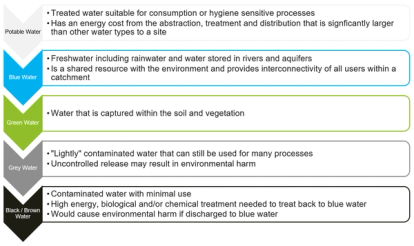
Why social impact must be accounted for like climate and nature
by Clodagh Connolly, Nicola Inge, Andres Schottlaender
View post

Readily accessible and comparatively cheap, it is easy to forget water is a resource, and a limited one at that. Circular Economy initiatives seek to eliminate waste, protect the source and provide economic and environmental resilience. These aims are mirrored in water stewardship, a stakeholder-inclusive and catchment-driven approach to water management. Here we look at how water stewardship can contribute to a business’s Circular Economy initiatives and sustainability objectives.
Water, like all resources, is unique from each source. It naturally contains different minerals and ions relating to the aquifers and watercourses it passes through. This variability can affect its usefulness in process engineering, as well as its taste. Once a source is depleted or damaged beyond what natural process can renew, replacement options are not the same.
The uses and costs associated with water change over its lifecycle as shown in the figure below. Returning water to a higher quality type is energy, chemically, and economically costly. Organisations should opt for the lowest quality water that fulfills their needs to support Circular Economy and water stewardship initiatives.

Businesses can take on various water stewardship schemes that observe Circular Economy principles, including:
Black or brown water mark the end of water's untreated usefulness, necessitating treatment before reuse. However, this presents an opportunity. Wastewater treatment options can generate energy for the facility or recover valuable nutrients. For instance, nitrogen and phosphorus in water bodies cause environmental damage and deplete the quality of water resources, but when extracted, they can be transformed into essential fertilisers for agriculture.
Traditional water management dealt with one problem at a time. Water stewardship takes a holistic approach to water management and encourages an integrated system addressing all water needs. Integrated water resource management is a truly Circular Economy approach, wherein one problem can be the solution to another. Water stewardship takes this management technique beyond the fence line - for example, runoff from a residential area could be collected to provide greywater for use at an industrial site. Taking this more holistic approach creates additional water efficiency and can provide significant environmental and cost savings.
Maintaining the quality of resources is a critical aspect of the Circular Economy. Even the smallest amounts of pollution can add up across a catchment area, impacting the water source for everyone and causing harm to the environment and biodiversity. Taking action at a catchment scale ensures that no negative effects are felt throughout the entire area, not just near where the discharge occurs. This not only reflects the principles of water stewardship and the Circular Economy but also provides a proactive sustainable feature for business, shielding it from any potential harm to its reputation or one of its most vital resources, water.
Both water stewardship and Circular Economy approaches inspire collaboration beyond organisational boundaries. This promotes the sharing of innovative ideas, minimises redundant efforts and enables projects that may not be feasible for a single organisation due to economic, technical or time constraints.
Core to the Circular Economy and water stewardship is the act of advocating for clarity on delivery, findings, risks, and opportunities for all. Public awareness and educational actions help to move resource management from an adversarial model to a collaborative community, fostering creative and innovative thinking.
The principles of the Circular Economy and water stewardship are united in their goal of promoting resource efficiency, protecting the environment, and building economic resilience. Water stewardship provides a pathway for companies to embrace a Circular Economy in managing water supply, utilisation, and discharge. SLR are experienced in delivering both circular economy and water management projects across sectors. Whether you are considering water risks for the first time and need a high-level risk screening across a portfolio of sites or wish to undertake a deep dive into water stewardship at your facility or along the supply chain we can build a bespoke scope for you. To find out more, please get in touch.